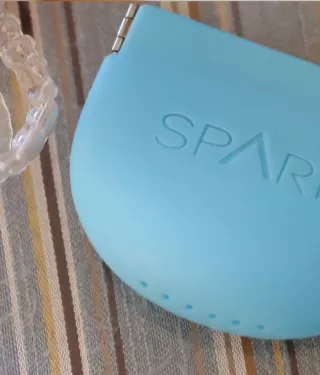Retainers Vs. Aligners
What’s The Difference And Can An Aligner Be Used As A Retainer?

Have you found that your teeth have shifted a bit after completing braces or aligner treatment? If so, you are not alone. In fact, a surprising number of patients are not compliant with their doctor’s advice to wear a retainer when their treatment ends. Many patients are so happy to be finished with orthodontic treatment that they ignore the recommended full-time or overnight wear of a retainer. Then, when they see tooth movement, they try to put in a retainer that may no longer fit since their teeth have begun shifting back to their pre-treatment state. Sometimes, the patient may not even be able to find their retainer and aren’t sure how to go about getting a new one.
This article is designed to break down the differences between retainers and aligners, and clear up some confusion between the two, as well as offer some helpful tips.
Do I really need to wear a retainer after treatment?
Yes, although it may not be popular, retainers serve an important purpose in maintaining the great smile you have worked hard to achieve through your braces or aligner treatment. Initially, unless you have a permanent retainer bonded in place, retainers should be worn full-time except when consuming foods or brushing your teeth, similar to clear aligners. But then, in accordance with your doctor’s prescription for you, you often can move to just nighttime wear.
Can I use my last aligner in lieu of getting a retainer or if I lose my retainer?
The American Association of Orthodontists advises every patient to wear a retainer, as prescribed by their doctor, to avoid teeth moving back to a less desirable state than the smile you achieved with braces or aligner treatment.
The biggest difference between retainers and aligners is that they are made from different materials with opposite goals. Retainers are designed to prevent teeth from moving, while aligners are designed to enable teeth to move into a more desirable location through constant gentle forces. Aligners are not designed to be a long-term solution to keeping teeth in a finished state. Aligners are meant to only be worn for about two weeks, so they won’t last as long as a retainer would.
Before we go into more detail, it might be helpful to provide a brief overview of retainers vs aligners.
What are teeth retainers, and how do they work?
A retainer is an orthodontic appliance used upon completion of braces or aligner therapy to keep treated teeth in their new location, ideally for life. As you can find on the American Association of Orthodontists website (AAOinfo.org), there are three main types of retainers: Removable plastic, removable wire and plastic, and permanent wire. These include:
Removable Retainers:
- Wire retainers are made of a wire and a plastic-like material. The part of the retainer that covers the roof of the mouth or goes behind the lower front teeth is a pink or flesh-colored plastic. It is connected to wires that go around your upper and lower teeth to hold them in place. This is often referred to as a Hawley retainer.
- Clear retainers are transparent trays made from specially engineered plastic material that fits snugly over your upper and lower teeth like an aligner set. They are made from a more durable, rigid material meant to last a long time and prevent tooth movement vs aligners that are made of a different, less durable type of plastic material specifically designed to move teeth with gentle, continuous force. These can be referred to as "Essix Retainers."
Fixed or Permanent Retainers:
- A fixed retainer consists of a thin, custom-fitted wire that is bonded to the tongue-side of the upper and lower front six teeth. These must be monitored for wear and tear and ultimately removed by an orthodontist, as they are affixed to your teeth.
Your orthodontist will recommend a removable or permanent retainer, or a combination of the two, depending on the orthodontic problems you had corrected. Retainers are made from a digital scan of a physical impression of your teeth. You will get a prescription from your doctor that outlines the right appliance, when to wear it, and for how long. Follow your prescription for the best results. If you do not, your teeth may not just move a little but enough where your retainer no longer fits, which can cause more problems or require additional treatment to fix.
What are clear aligners and how do they work?
Aligners are a series of custom manufactured, clear plastic, removable trays that incrementally and consistently move teeth with gentle force from their original state to a more optimal, treated state.
Each aligner set shifts teeth by up to 0.2 mm by changing the shape of your dental arch in order to align the teeth. Patients with crowded or crooked teeth will need their arch widened to make more room. For patients with spaced-out teeth with gaps, the aligners may try to narrow the arch to close up some of that extra space. These incremental movements need to be carefully planned by your orthodontist so that your upper teeth, lower teeth and bite perfectly fit together for proper oral health.
Patients are instructed to wear their aligners 22 hours a day and, dependent on their doctor’s guidance, change their aligner set every 1 to 3 weeks over the course of their treatment. Treatment time varies depending upon a patient’s diagnosis and the recommended treatment approach. With 3D scans of your mouth and sophisticated software, an orthodontist can explore different treatment approaches using an aligner to perfect the best treatment plan for you and even show you what your finished smile will look like before the first aligners are even made.
What do I do if my teeth have shifted following braces or aligner treatment?
Even if your teeth have shifted a bit, the good news is that you don’t need to fret. It is easy to correct minor tooth regression with clear aligner therapy and new retainers. Now that you know the differences between the two and their purposes, you can be more confident in maintaining your smile. Consult your orthodontist to determine if you are a candidate for this minor corrective treatment with a removable, clear aligner such as Spark Clear Aligners.
If you have lost an existing retainer or are seeking a more contemporary, clear dental retainer, you also should make an appointment with your orthodontist.
To learn more about aligners vs retainers or therapy for teeth that have shifted following orthodontic treatment, speak with a trained Spark orthodontist. You can find one here.



